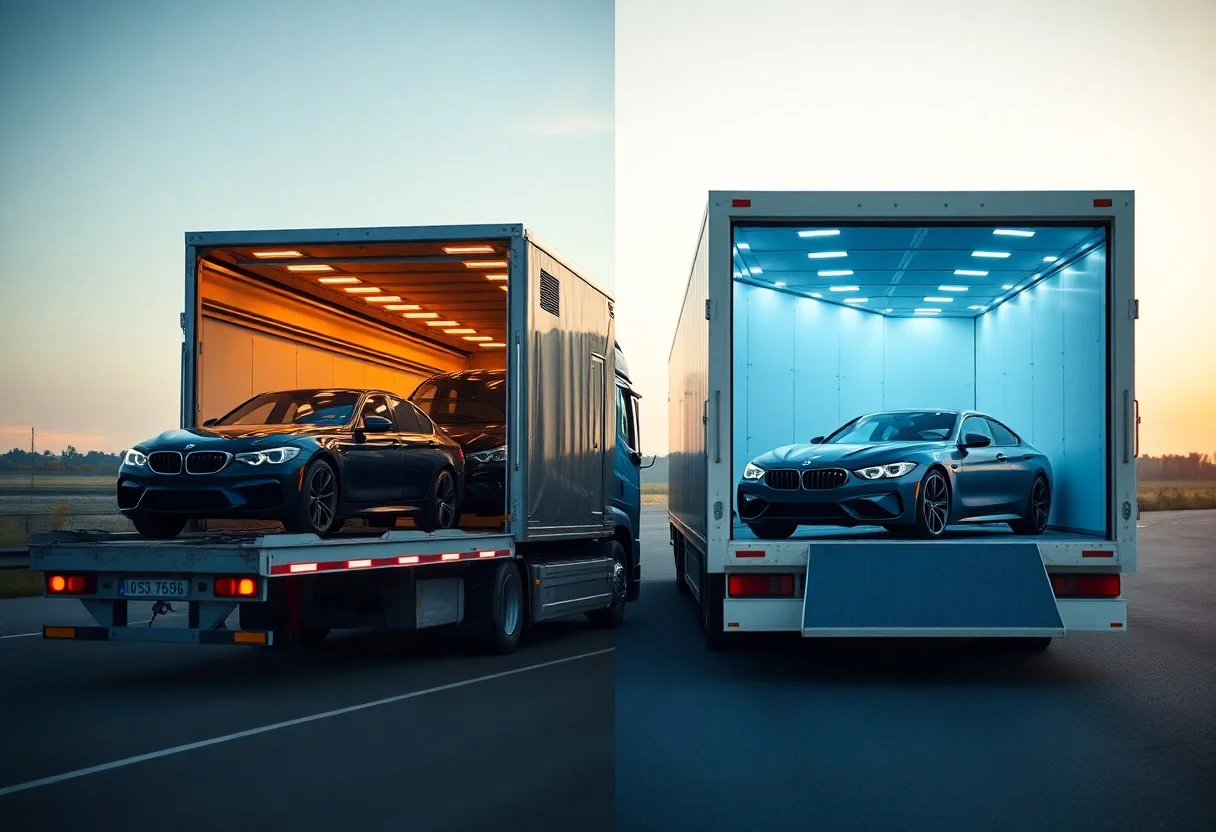In today’s fast-paced world, shipping your car across states or even across the country has become more common than ever. Whether you're relocating, buying a car online, or sending a vehicle to a loved one, choosing the right auto transport method is crucial. In 2025, the two most common car shipping methods remain: open trailer car shipping and enclosed car shipping.
But which one is the best option for you? Let’s explore both in detail so you can make an informed decision.
🚚 What is Open Trailer Car Shipping?
Open trailer car shipping, also known as open carrier car shipping or open transport car shipping, is the most commonly used vehicle transport method in the USA. Your car is loaded onto an open trailer—typically along with 7 to 10 other vehicles—and transported to its destination.
These trailers have no walls or roofs, meaning your car is exposed to outdoor elements during the journey.
✅ Advantages of Open Car Transport
• Cost-Effective: It’s the most affordable way to ship a vehicle.
• Faster Scheduling: Since open trailers are widely used, you’ll often get quicker pickup and delivery times.
• Highly Efficient: These trailers can transport more vehicles at once, reducing fuel use and emissions.
• Best for Everyday Vehicles: Perfect for standard sedans, SUVs, trucks, and used cars.
❌ Disadvantages
• Exposure to Weather: Rain, snow, sun, and dust can reach your vehicle.
• Potential for Road Debris: While damage is rare, your car is more vulnerable to dirt or minor debris.
• Less Privacy: Your vehicle is visible during transport.
🚛 What is Enclosed Car Shipping?
Enclosed car shipping involves transporting your vehicle inside a covered trailer. These carriers protect your car from the elements and are often used for high-value or specialty vehicles such as: • Luxury cars • Antique or classic cars • Exotic sports cars • Restored collectibles • Custom or show cars
Enclosed trailers typically carry fewer vehicles (1–5) and offer greater privacy and protection.
Advantages of Enclosed Transport
• Maximum Protection: Your car is safe from weather, dust, debris, and road conditions.
• Ideal for High-Value Vehicles: Offers extra care and insurance for expensive or rare vehicles.
• Added Security: Enclosed trailers are harder to access and offer more privacy.
• Special Handling: Drivers are trained to load and secure specialty vehicles using lift gates and soft straps.
Disadvantages
• Higher Cost: Typically, 30–60% more expensive than open trailer shipping.
• Limited Availability: Fewer enclosed carriers mean longer wait times.
• Not Necessary for All Cars: Overkill for standard or already-used vehicles.
📊 Side-by-Side Comparison
Feature | Open Trailer Car Shipping | Enclosed Car Shipping |
Cost | Budget-friendly | Premium pricing |
Vehicle Protection | Moderate (exposed) | High (fully enclosed) |
Ideal For | Standard, daily-use vehicles | Luxury, antique, or exotic cars |
Availability | Very high | Limited |
Scheduling Flexibility | Easier to book | May take longer |
Security & Privacy | Basic | Enhanced |
Insurance Coverage | Standard (up to $100,000) | Higher (up to $250,000+) |
💰 What Does Each Method Cost in 2025?
Costs can vary depending on distance, vehicle type, and time of year. Here's a general range for a 1,000-mile shipment:
• Open Transport: $800 – $1,100
• Enclosed Transport: $1,300 – $1,800+
You’ll pay more for enclosed shipping due to the extra protection, insurance, and specialized service. However, open shipping remains the most economical choice for most vehicle owners.
🔋 2025 Trends: How They Affect Your Choice
Electric Vehicle Transport
With EVs becoming more popular, both open and enclosed transport methods are adapting. Many EVs (like Teslas and Rivians) are shipped via open trailers, but owners of high-end electric cars often prefer enclosed trailers for added battery protection and overall care.
Technology & Tracking
Both methods now offer real-time GPS tracking, giving customers more transparency and peace of mind.
Eco-Friendly Shipping
Open trailers remain the greener option due to fuel efficiency. However, many enclosed carriers are also moving toward clean energy and carbon offset programs.
🧠 Which Method Should You Choose?
✅ Choose Open Trailer Car Shipping If • You want the most cost-effective solution • You’re shipping a daily driver, used car, or non-luxury vehicle • You need fast pickup and delivery • You’re not concerned about minor exposure to elements ✅ Choose Enclosed Car Shipping If • You’re shipping a luxury, antique, or exotic vehicle • You want maximum protection from weather and road conditions • You’re transporting over long distances • You’re willing to pay extra for peace of mind
🛠️ How to Prepare Your Car for Shipping (Both Methods)
No matter which service you choose, here’s how to get your vehicle ready:
1.Clean the exterior – Makes it easier to inspect and document condition.
2.Remove personal items – These aren’t covered under carrier insurance.
3.Take photos – Document your car’s condition before pickup.
4.Check tire pressure & fluids – Make sure it’s roadworthy.
5.Leave only 1/4 tank of fuel – Enough for loading/unloading but not too much weight.
📦 Real-World Use Cases
• Jack, a college student, used open trailer car transport to ship his Honda Civic from California to New York affordably and on time.
• Linda, a collector, used enclosed shipping to safely send her classic 1969 Corvette to a car show in Florida.
• A family moving cross-country used open car transport to move both their SUVs, saving hundreds of dollars.
🏁 Final Thoughts
The choice between open vs. enclosed car shipping depends on what’s most important to you: cost, protection, or peace of mind.
If you’re looking for a reliable, affordable, and fast way to move a standard vehicle, open trailer car shipping is the best solution.
If your vehicle is high-value, delicate, or one-of-a-kind, enclosed auto transport is worth the investment.



